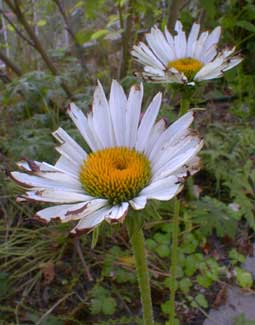
'Fragrant Angel'
White Coneflower
"These flowers are coming up wild
They're coming up, they're coming up
They're coming up wild."
-Martha Wainwright,
b.1977
b.1977
Introduced by Dan Heims of Terra Nova Nursery in Tigard, Oregon, Echinacea purpurea alba 'Fragrant Angel' could potentially have displaced 'White Swan' as the standard white echinacea, as 'White Swan' though very hardy is not as ultra-hardy as regular purple echinacea, & it lacks a noticeable fragrance.
But it is, if anything, less hardy than 'White Swan,' all things being relatively, so that 'White Swan' is apt to remain the standard white. Furthermore, alas, the promise of perfume from 'Fragrant Angel' comes as quite an exaggeration by the assessment of many a snout. It does have a mild honey-phlox perfume which older cultivars don't possess, but you kind of have to concentrate with your nose right in it to detect this.
Getting scent into coneflowers has been one of the new breeding priorities. But for 'Fragrant Angel,' the scent is not such a wondrous perfume as to make a major difference, though it's nice.
Terra Nova says 'Fragrant Angel' blooms should reach four or five inches across which would be bigger than 'White Swan,' but in our garden the long-established 'White Swan' has much the bigger flower though it's a much shorter clump.
Its first year for us, 'Fragrant Angel' struggled to get established (they can be sensitive to summer heat until their root system is well out), & the flowers were barely three inches wide, though frillier looking than for 'White Swan,' the overlapping petals being arranged in two rows instead of the usual one. This full-bodied frilly look means many a gardener will want both 'White Swan' & 'Fragrant Angel.'
The August photo above shows the heat-stressed & tip-burned blooms of 'Fragrant Angel.' Even with sufficient watering it needed more protection from August heat than the other echinaceas demand. This may be only its first-year response, & it should reach a higher level of heat-hardiness by its second summer. It bloomed continuously from July to October; it'd likely be finished flowering in September in colder zones.
Most of the old standard coneflowers have shuttlecock flowers strongly reflexed. They look wilted to the unfamiliar eye but are preferred by coneflower lovers. 'Fragrant Angel' keeps its petals straight out & perky, more like daisies than shuttlecocks. This look might really improve sales because I remember when I was a novice gardener, I was slow to warm to echinaceas because of the wilted-daisy impression. I now take their badminton-birdie appearance so for granted that varieties that are not reflexed are what takes the getting used to.
Although echinaceas are winter-dieback perennials, in our mild zone they don't always go entirely dormant, & can be producing half-finished flowers deep into autumn. If this is discouraged by clipping off any attempted late-autumn blooms, the clump will instead expend that energy spreading its root system more quickly.
When the petals are spent, the large yellow-orange cone turns black & remains rather decorative in its own right, attracting finches that cling to the stems & peck at seeds in the cones. The cones can be left through winter or removed at any time when they are no longer attractive, but certainly cut back before spring's new growth.
Continue to:
'Sundown' Echinacea